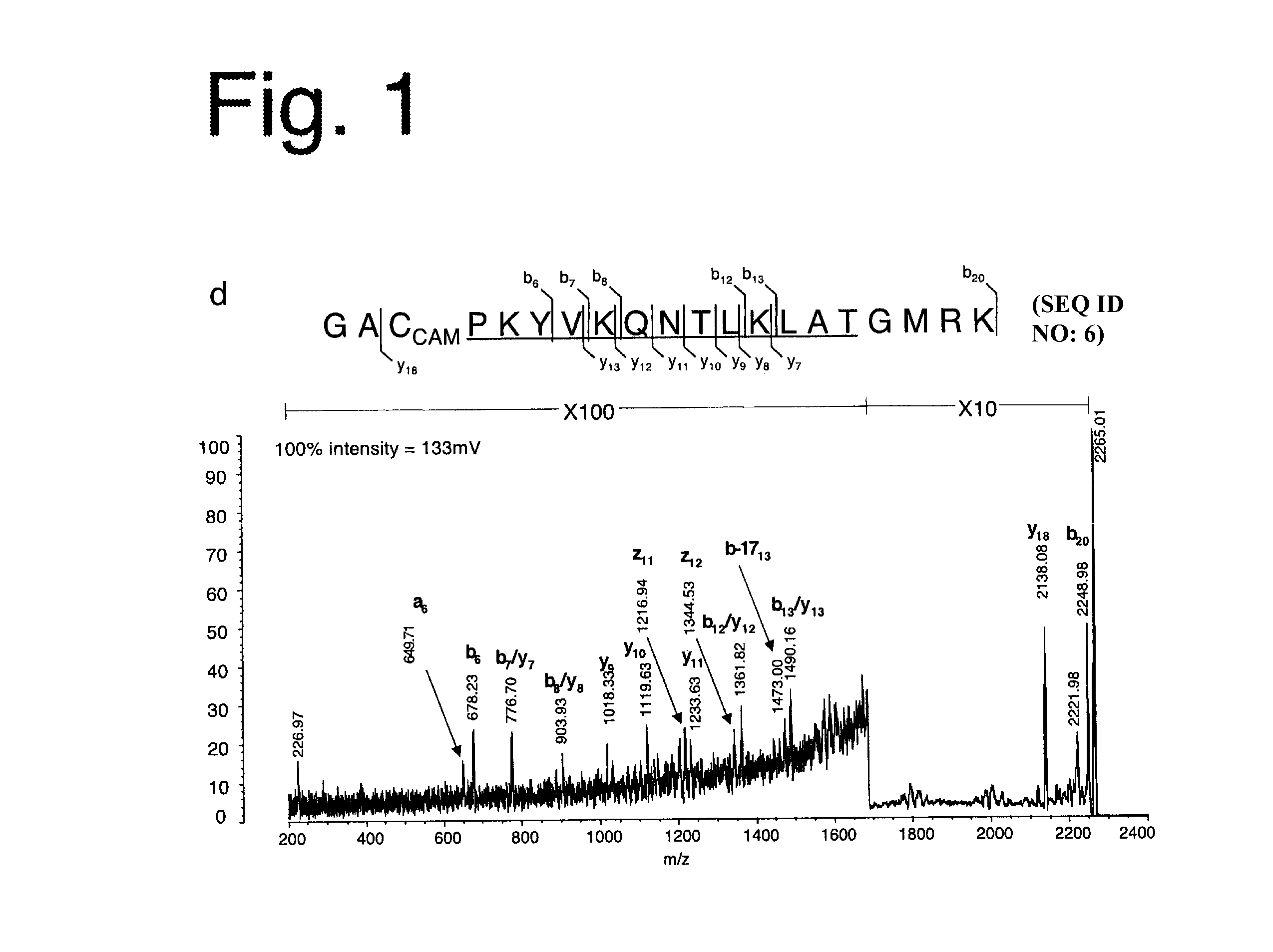Method for identifying and validating dominant T helper cell epitopes using an HLA-DM-assisted class II binding assay
a technology of helper cell and binding assay, which is applied in the field of biochemistry and immunology medicine, can solve the problems of inability to characterize individual peptides, and inability to detect actual immunogenic peptide sequences
- Summary
- Abstract
- Description
- Claims
- Application Information
AI Technical Summary
Benefits of technology
Problems solved by technology
Method used
Image
Examples
example i
Materials and Methods
Production of Recombinant Proteins
[0119]Soluble HLA-DR1*0101 and DM were produced as described previously (Stern L I et al., Cell 68:465-77 (1992)) and expressed by “Hi-Five”™ cells (Invitrogen) transduced by recombinant baculovirus containing genes for the α and β chains of human HLA-DR1*0101 and DM lacking their transmembrane and cytosolic domains. The DM α and β chains were genetically modified to possess the FLAG epitope (DYKDDDDK; SEQ ID NO:2) and the cMyc epitope (EQKLISEEDL; SEQ ID NO:3), respectively, at their C-termini. Soluble DM was purified from the culture supernatant by immunoaffinity chromatography with the M2 (anti-FLAG) mAb sepharose resin (Sigma) at pH 6.0, and eluted with FLAG peptide in PBS, further purified by gel filtration chromatography (Superdex 200 HR 10 / 30 column, Amersham-Pharmacia).
[0120]Influenza hemagglutinin HA1 was produced in E. coli. Expression was induced in by the addition of 1 mM IPTG. Bacterial cells were pelleted after 5 h...
example ii
Analysis of Influenza HA Protein
[0124]The influenza HA protein, a well-characterized antigen with a known HLA-DR1-restricted immunodominant epitope, was analyzed. When HLA-DR1+ individuals are infected with influenza strain A / TexasI1177, an epitope made up of residues 306-318 of the HA1 subunit (HA306-318) having a sequence PKYVKQNTLKLAT (SEQ ID NO:5) near its C-terminus emerges as the immunodominant epitope (Lamb, J R et al., Nature 300:66-9 (1982)).
[0125]The present inventors used a recombinant form of HA1 derived from strain A / PR / 8 / 34 to which the A / Texas / 1 / 77-derived HA306-318 epitope was (genetically) fused near the C-terminus where it is naturally present. The resulting protein, susceptible to digestion by cathepsins B and H (FIG. 5), was incubated first with HLA-DR1, with or without DM, and then with cathepsins. HLA-DR1 in the DM-free reaction was induced to adopt a peptide-receptive conformation through pre-incubation with HAy308A, a point mutation of the HA306-318 peptide (...
example iii
Analysis of Type II Collagen
[0130]The present system was next applied to type II collagen (CII), the suspected autoantigen in rheumatoid arthritis (RA) (Trentham, D E et al., J Exp Med 146:857-68 (1977); Yoo, T J et al., J Exp Med 168:777-82 (1988)) The DR1-restricted immunodominant epitope of CII is known to be comprised of residues 282-289, FKGEQPGK (SEQ ID NO:7) (Rosloniec, E F et al., J. Immunol. 160:2573-8 (1998)). Bovine CII was used because it is 98% identical in sequence with human CII and the CII282-289 epitope is conserved.
[0131]Bovine CII (bCII) was digested with matrix metalloproteinase (MMP) 9 (FIG. 6), a neutrophil protease suspected of generating immunologically active CII fragments in RA and known to leave the CII282-289 epitope intact (Van den Steen, P E et al., FASEB J 16:379-89 (2002); Van den Steen, P E et al., Biochemistry 43:10809-16 (2004)).
[0132]The bCII fragments were incubated with HLA-DR1, with or without DM, and were then incubated with or without catheps...
PUM
 Login to View More
Login to View More Abstract
Description
Claims
Application Information
 Login to View More
Login to View More - R&D
- Intellectual Property
- Life Sciences
- Materials
- Tech Scout
- Unparalleled Data Quality
- Higher Quality Content
- 60% Fewer Hallucinations
Browse by: Latest US Patents, China's latest patents, Technical Efficacy Thesaurus, Application Domain, Technology Topic, Popular Technical Reports.
© 2025 PatSnap. All rights reserved.Legal|Privacy policy|Modern Slavery Act Transparency Statement|Sitemap|About US| Contact US: help@patsnap.com



